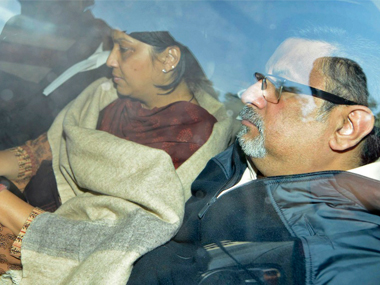On Thursday afternoon, a bench of justices BK Narayana and AK Mishra at the Allahabad High Court acquitted Rajesh and Nupur Talwar in the Aarushi-Hemraj double murder case. The bench gave judgment giving Aarushi’s parents, who are currently lodged in Ghaziabad’s Dasna jail, the benefit of the doubt.
Previously, the case saw three full investigations: One by the Uttar Pradesh police, and the remaining two by the CBI. Only the second probe pointed to the Talwars’ innocence in the murder of their daughter Aarushi, while the other two charged them with double murder.
In all this, the key turning point in the case which led to a full-blown trial and pointed towards the Talwars’ innocence was when the two pillow covers were recovered: One was Hemraj’s pillowcase from the Talwars’ flat, and the second, a purple pillow cover belonging to Krishna — one of Hemraj’s three Nepali friends — with Hemraj’s blood on it seized from Krishna’s house who lived in L-14, Jalavayu Vihar, a few houses away.
As Avirook Sen details in his 2015 book Aarushi , the presence of Hemraj’s blood on Krishna’s pillow cover pointed to an outsider’s involvement in the murder, disputing CBI’s claims of Rajesh and Nupur Talwar being responsible for the murders.
Rajesh’s brother Dinesh Talwar found the evidence hidden in Document 48 in a handful of files handed to them by the CBI. Dinesh informed the Talwars’ lawyer Rebecca John immediately who filed an application based on it in the Allahabad High Court.
Strangely, days after Rebecca John filed the affidavit, two photographs of the exhibits materialised on 10 March, 2011. Each of the photographs showed two pillow covers, one belonging to Hemraj and other to Krishna’s, with scraps of paper having handwritten markings labelling them. However, these did not resemble any stationery from Centre for DNA Fingerprinting and Diagnostics (CDFD), Hyderabad, which tested the two pieces of evidence.
In the initial report submitted in 2008, Hemraj’s pillow cover was labelled as Z-14 and Krishna’s Z-20. But in the photographs shown in 2011, the labels were interchanged which meant that Hemraj’s DNA was found on his own pillow cover and nothing on Krishna’s. The court was shown these photos and told it was a result of “a typographical error”. Moreover, the photograph was not submitted to the court as evidence but merely waved in front of the judge.
However, the unexplained part in all this is how the two pillowcases were photographed without a court order and when they were under seal. The pillow covers must have been kept in sealed envelopes with CDFD’s seal. Somebody, not from the CDFD, opened them and took the photos, wrote Sen. On 17 March, the Allahabad High Court said that it was ‘clear’ from the photographs that it was a “typographical error”.
Incidentally, the sealed packages were under CBI or CDFD’s care at the time. One of the scientists from CDFD Madhusudan Reddy told Sen that the photographs were not taken at the lab. The labels shown in the photograph were undated and unsigned, and whoever swapped the exhibit numbers added a serial number where none existed. Additionally, the CDFD, which prepared the original report, was never contacted to confirm if it was indeed a “typographical error”.
The CDFD issued a brief clarification and called it a typographical error only after the court declared it so and CBI investigator AGL Kaul travelled to the lab in Hyderabad. This alleged “error” also came to light after the Talwars’ filed the affidavit in the court.
Sen writes in the book, “What the Talwars hadn’t realised at the time was that a trial was inevitable. Had they kept the secret of Document 48 to themselves, all they would have had to do was ask a CDFD scientist if he stood by the report during the trial. That would have authenticated the document. And by then, it would be too late for anyone to turn Z-20 into Z-14.”


)




)
)
)
)
)
)
)
)